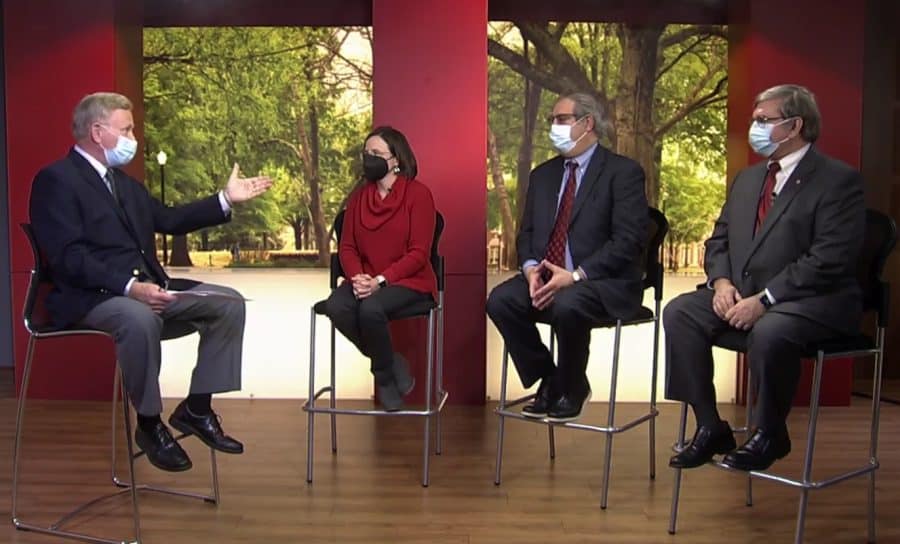UA health officials express optimism, stress precautions in COVID-19 town hall
January 20, 2022
In a virtual town hall on Wednesday, three University of Alabama health officials shared a positive outlook on the future of the COVID-19 pandemic but reiterated the importance of precautions like masks, social distancing and vaccination.
University Medical Center and WVUA 23 hosted the event, and WVUA 23’s Mike Royer led the discussion.
‘Not so much a surge but a spike’
The three officials at the town hall were Dr. Karen Burgess, who serves as the College of Community Health Sciences’ assistant dean for academic affairs and the chair of the Department of Pediatrics; Dr. Richard Friend, the college’s dean; and Dr. Thomas Weida, the college’s associate dean for clinical affairs and UMC’s chief medical officer.
The town hall, which was broadcast live from UMC’s Facebook page, came one day after the UA System updated its COVID-19 dashboard for the first time since the fall 2021 semester.
According to the dashboard, which includes test results from campus facilities and self-reported results, 358 students and 140 employees at The University of Alabama tested positive for COVID-19 between Jan. 10 and 16 — more than twice as many positives as were reported for the week of Aug. 23 to 29, when campus cases peaked last semester.
The omicron variant now accounts for the majority of new cases in the country. In Tuscaloosa County, as many as 4,000 cases have been recorded in a single week, according to the Centers for Disease Control and Prevention.
DCH Health System reported Tuesday that 114 patients were currently hospitalized with COVID-19, including 17 in the intensive care unit. Weida said that almost all ICU patients were not fully vaccinated.
The positivity rate in the state is 44%. Reported campus numbers are “somewhere between 15% to 20% lower,” according to Friend. Weida said this rapid uptick in cases is likely to be followed by a rapid decline in transmission.
“Hopefully this is not so much a surge but a spike, and so then it’ll go up, and it’ll go down a lot quicker than the other surges did,” Weida said.
In-person instruction
Some universities started the semester online, but Friend said it is his goal to continue in-person classroom activity. He expects to see a downward trend in campus cases at the end of January or beginning of February.
The current trend has led to staffing shortages at the Student Health Center and University Medical Center.
“We are having to move personnel around,” Friend said. “In a contingency plan, we may be forced to close one particular clinic.”
Friend said none of the services provided to students, faculty and staff will be diminished.
The University was utilizing numerous metrics to determine the safety of remaining in person, but according to Friend final decision making for COVID-19 policy lies with UA President Stuart Bell, who is advised by the University’s COVID-19 Strategic Response Team.
“Based on national and statewide trends, the UA System Health & Safety Advisory Committee expected an increase in case numbers,” the UA System said in a statement on Jan. 19. “We know in-person learning and an on-campus experience improve student success, so it remains important that we maintain those opportunities while following safety measures that have proven to be effective in reducing COVID transmission.”
Vaccines, masks and other precautions
The omicron variant has driven an unprecedented acceleration in case counts, but it appears to cause milder symptoms than the delta variant, especially for people who are vaccinated and boosted, Weida said.
“[The] most important thing is getting a vaccine, getting fully vaccinated and then getting a booster,” Friend said. “We’re following the science right now on the fourth booster, from some data out of Israel. And so we’re going to be prepared for that if that happens. I don’t think that the fourth booster is going to be recommended, but I do think there will be annual COVID boosters, COVID shots recommended for the general population.”
In addition to vaccines, the officials stressed the importance of other safety measures, such as masks and social distancing.
Recent studies have shown that the cloth masks that many began using at the onset of the pandemic in 2020 are the “least protective,” according to the Centers for Disease Control and Prevention. Some universities, like Cornell University, have opted to ban cloth masks on their own, requiring students on their campus to wear higher-end masks such as N95s and KN95s.
Friend said these are only necessary for medical professionals taking care of a patient with COVID-19, despite numerous studies saying that cloth masks, even when well-fitting, do not provide adequate protection.
“The KN95 and N95 are really important in direct settings such as a provider taking care of a patient that may have COVID. For the general public in an indoor setting a well-fitted mask or double-masking is probably just as effective,” he said.
“One mask is better than no mask,” Weida said, adding that surgical masks offer more protection than cloth face coverings and that KN95 and N95 masks offer the most protection.
Friend was nervous about the large gatherings last football season but “quickly learned that you can have 100,000 people in an outdoor setting, a large majority of which are not vaccinated, and we didn’t see large upticks.”
“When you have it [events] outdoors, if you can have it outdoors, that’s much safer than having it indoors. If you do have it indoors, you should be masked, you should have good ventilation, and you should keep the crowds to a minimum.”
Weida said transmission of COVID-19 is most common in places like restaurants and bars and between members of a household. Having COVID-19 once, Friend reminded attendees, doesn’t necessarily prevent future infection.
Testing and treatment
University medical officials have seen a recent increase in testing availability to meet increased demand.
“As quickly as this spreads, there have been a lot of testing requirements that have taken place, and we’ve really seen the number and the volume of tests increase over the past week or so,” Burgess said.
Sentinel, entry and exit testing have not been in place since the spring 2021 semester. According to Friend, a return to sentinel testing of the student population is not on the table at this time.
“Now we know from previous experience and from data across the country and the world that sentinel testing an asymptomatic population is not an indicator of anything. We know it’s not an indicator, a good indicator in formation of policy,” Friend said.
The University has not publicly reported the number of COVID-19 tests conducted at its medical facilities. Burgess said supply constraints have necessitated the restriction of testing to individuals with COVID-19 symptoms or who have been exposed to someone infected with the virus.
One option for treatment is monoclonal antibodies, which Friend said have been in short supply throughout the pandemic. Friend said the most abundant monoclonal antibody, Regeneron, is not effective against omicron in the lab.
Sotrovimab is a monoclonal antibody effective against omicron, which is unavailable at the University because it’s in short supply across the country.
Another option comes in the form of two pills that received emergency use authorizations from the Food and Drug Administration in late December, molnupiravir and Paxlovid.
“The Paxlovid is highly effective, even more effective than the monoclonal antibodies in keeping people out of the hospital and [from] getting seriously ill,” Friend said. “Again, very short supply, they’re ramping that up. We hope to have a supply of that here for those who need it.”
Questions? Email the News desk at newsdesk@thecrimsonwhite.com.





















